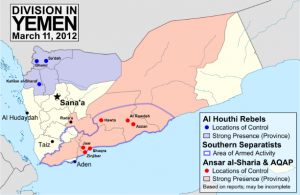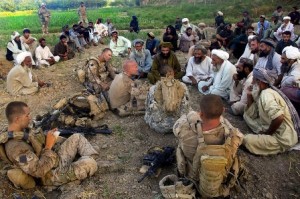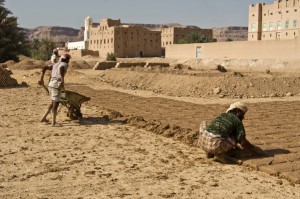
Adapting a Strategy for Yemen’s Dual Threat

Photo Credit: Political Geography Now
Counterterrorism concerns have long preoccupied much of U.S. foreign policy in Yemen over the past decade, and rightly so given the global aims of the Yemen-based al-Qaeda affiliate, al-Qaeda in the Arabian Peninsula (AQAP). The State Department has labeled them the most lethal branch of the al-Qaeda organization. However regional changes and recent developments in Yemen require that the U.S. broadens its strategic approach.
Today as Yemen attempts to forge a new government after the 2011 revolution that ended President Ali Abdullah Saleh’s 33 year reign, political factions continue to hamper attempts at reform. (For more information, see this updated ASP Fact Sheet on Yemen.)
These divisions create a dangerous political vacuum in the country, one which AQAP has not hesitated to exploit.
Despite AQAP’s previous attempts against worldwide targets, the organization’s focus seems to have shifted inwards to domestic power consolidation. AQAP has not publicly pursued a U.S. target since the failed 2010 attempt to smuggle bombs on a U.S. cargo plane, and the group has suffered key losses in its upper ranks with the deaths of Anwar al-Awlaki and recently Saeed al-Shihri.
On the other hand, AQAP made significant territorial advances after the 2011 revolution in Yemen paralyzed the country’s security framework. Much of the land has since been retaken through a costly campaign by the Yemeni military, but AQAP continues to target the Yemeni government and military.
The emergence of Ansar al-Sharia, however, complicates the nature of the threat posed by AQAP. Often referred to as the political wing of AQAP or simply an al-Qaeda rebranding effort, Ansar al-Sharia has orchestrated an insurgency in South Yemen, engaging the tribal-political network and carrying out attacks against Yemeni forces.
 The U.S. State Department officially lists Ansar al-Sharia as an alias of AQAP, yet some analysts, including former Ambassador to Yemen Barbara Bodine, see Ansar al-Sharia as a somewhat separate creature with significant implications.
The U.S. State Department officially lists Ansar al-Sharia as an alias of AQAP, yet some analysts, including former Ambassador to Yemen Barbara Bodine, see Ansar al-Sharia as a somewhat separate creature with significant implications.
As Ambassador Bodine and others have noted, Ansar al-Sharia has taken on a Taliban-like role in Yemen, using similar techniques such as attacking military and government sites while providing social services to the country’s rural poor, with the long-term goal of establishing an alternative government.
This highlights the need for a multifaceted approach, as the stability of Yemen significantly affects U.S. security interests given Yemen’s geopolitical location.
AQAP and Ansar al-Sharia still have enormous recruiting capabilities, and thus U.S. counterterrorism policies, in addition to the current concentration on eliminating high-ranking leaders, need to focus on groundwork strategies that assist the Yemeni government in orchestrating a counterinsurgency—a two pronged approach to a two-faced threat.
These strategies should address both economic issues and security concerns that jeopardize Yemeni stability.
Yemen currently suffers from extremely high unemployment, especially among Yemeni youth (40% according to the World Bank), who are much more susceptible to radicalization. Yemen’s currency has stabilized and some sectors have begun to recover, yet the unskilled labor industries like construction that many Yemenis depend on remain paralyzed, causing some to turn to other sources of income.
Christopher Swift has argued based on extensive interviews with Yemeni tribal leaders that economic factors have driven many Yemeni youth to join Ansar al-Sharia and AQAP’s ranks.
The U.S. should work with the Yemeni government, regional partners, and individual Yemeni businesses to prevent industries from relocating to foreign markets such as Saudi Arabia. Especially given the amount of time and focus the ongoing National Dialogue Conference has required from Yemeni officials, the U.S. must ensure that the Yemeni government has the manpower and institutional framework to protect vital infrastructure and revive the economy at this critical juncture.
The U.S. also needs to support the Yemeni government in equipping security forces for a counterinsurgency. U.S. agencies have learned much from the experience in Afghanistan, and thus can impart strategies that focus on making local political networks resilient and more involved.
Both Saudi Arabia and the U.S. should continue to engage in intelligence sharing and involve Yemeni agencies as much as possible, with the intention of both preventing future attacks and better understanding Ansar al-Sharia’s manipulation of tribal networks.
Dismantling AQAP’s leadership should remain a focus of U.S. counterterrorism policy, but officials need to recognize that AQAP and Ansar al-Sharia have merged insurgent and terrorist aims and adapt accordingly.
Don’t forget to check out ASP and Development Tranformations event next Tuesday on Yemen’s political transition.








[…] Adapting a Strategy for Yemen’s Dual Threat […]
[…] Adapting a Strategy for Yemen’s Dual Threat Ollie Engebretson U.S. counterterrorism policies in Yemen, in addition to the current concentration on eliminating high-ranking AQAP leaders, need to focus on groundwork strategies that assist the Yemeni government in orchestrating a counterinsurgency- a two pronged approach to a two-faced threat. […]